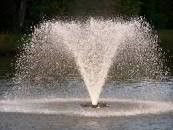A fountain can be just the ideal visual delight you look for in a pond. Whether it is a large pond or a small one, a fountain can overall transform the beauty of the pond.

Fountains come in various types, styles, and for creating different water landscapes, however, all are intended to bring one key aspect forward – keeping the viewers delighted with the kind of water show they love to watch.
Fountains – More than Just a Visual Amusement
If you are of the notion that the fountain is just for a graphical display, then it is not the case. There goes much more than what a fountain pump is for. It also helps to keep the pond environment healthy and lively. It helps in proper aeration of the oxygen through the pond water that keeps it odor-free. A pond fountain pump reduces the accumulation of sediments in the bottom of the pond, reduces the algae growth, and improves the overall water life in the pond.
Fountain Pond Pump – The Lifeline of the Fountains
What is it that keeps the fountains working efficiently? It is the pump. Yes, the fountain has a mechanism that it follows, and this mechanism works purely from the energy provided by the fountain pump. If there isn’t any pump, you can forget about having a fountain working.
So, it is safe to assume that for a highly functional and efficient fountain, the pump is its lifeline. So, it should be that you purchase fountain pond pump based on all the factors and specific requirements.
How To Select A Fountain Pond Pump?
Selecting a fountain pump isn’t a small decision. It takes more than just the design and the style of the pump. What is the size of the pond or the water feature that you want to buy the pump for? How much water is needed to be pumped or lifts within a given period? What is the type of water display? How much time the fountain has to be in function continuously? These are some of the basic things that you need to consider to choose the fountain pump. Small ponds or water features need a small power pump, but larger ponds or water bodies more robust pumps to lift the water.
You must know that picking a wrong one can cause severe problems, so your decision and process should be stringent one, to have the right establishment and for the better maintenance of the pond, by following the factors given below-
1. Submersible or External
You can find both submersibles as well as a centrifugal pump for your water body. While a submersible is easier to put into the water for concealing purposes, it becomes a bit tricky to clean and maintain it. While a centrifugal or external one can be cleaned easily but requires more maintenance and plumbing.
2. Amount of Water to Be Pumped
There are different volt based pumps, and each has a different capacity to lift and pump water in a given period of time. For a small fountain, a 120-volt pump will do good, but a 220-volt pump is specific for use in large-scale water circulation.
3. Pond’s Height and Width
Pond’s height and width are features that are key to how much water is to be lifted and spread-sprayed throughout the water body. Keeping note of these aspects will help you pick a pump rightfully knowing how much water it can move around up to what distance.
4. Get Pond’s Volume
Measuring the pond’s volume is also necessary, as it also helps to identify the strength of the pump that would be perfectly suitable for the water body. Pumps come in Gallons-Per-Hour (GPH) rating. And a suitable pump must be half in GPH in rating in comparison to pond’s volume. However, certain water feature fountains require high GPH rating pumps, which you must check beforehand.
5. Check Pump’s Head Rating
The head rating of the pump is about how much height the pump can achieve for lifting the water. It determines if the pump is suitable to be used for a display water feature, a waterfall, or any other type of water display.
6. Performance Chart of the Pump
Pumps come with a performance chart that denotes the efficiency of the pump considering the pressure changes and the change in performance with relation to the different heights fountain achieves. So, based on your pond’s or water bodies’ volume and in accordance with the GPH and head rating, coupled with the performance chart you will be able to come to a conclusion about which pump fits the need most effectively for you.
When you are out to buy fountain pond pump, digging deep, and assessing each and every factor will help you pick the most appropriate one, as it is an investment that you are going to make for durability and high-end performance.




Thanks a lot for sharing this. A well informative blog. Good Work. Keep it up